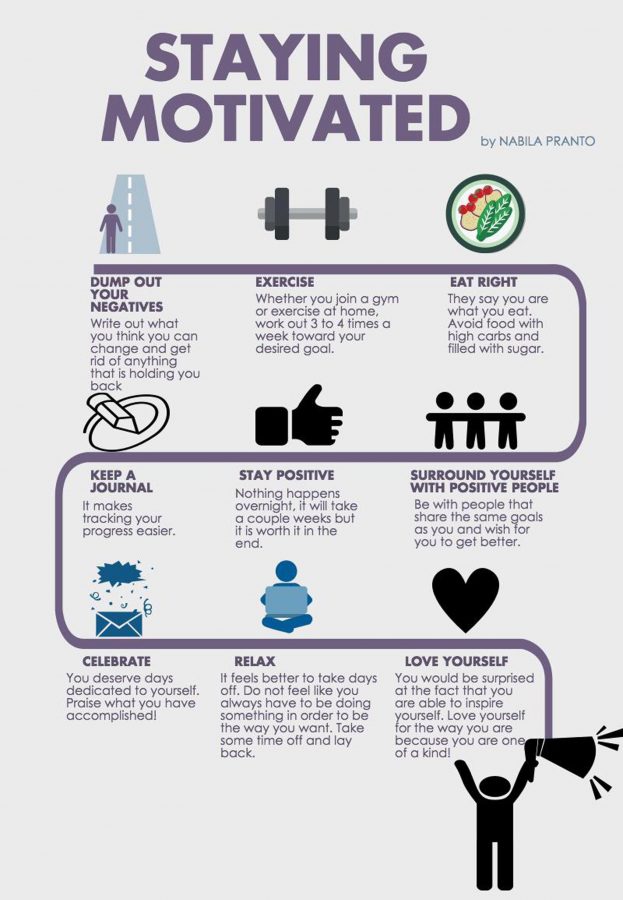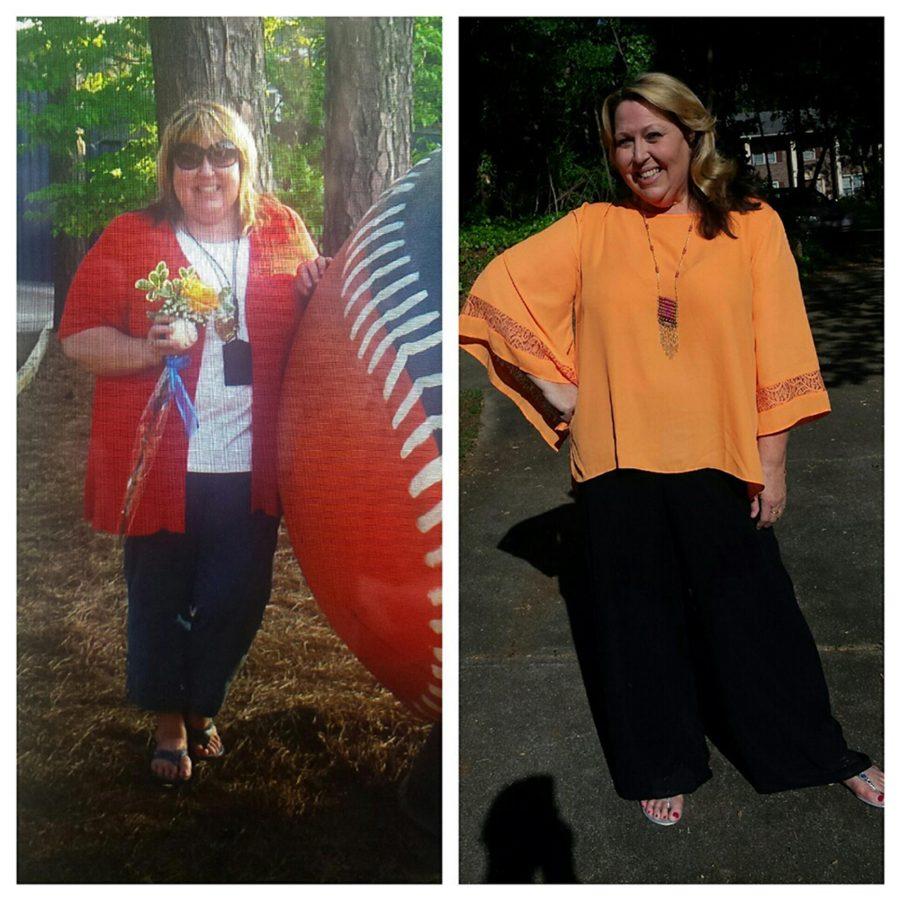Spreading body positivity one pound at a time
May 16, 2016
Stepping on a scale and praying that the weight from last week decreased by a pound or two, looking in the mirror and seeing lovehandles spill over the top of my pants, laughing at a meaningless joke about the size of my thighs but constantly hiding them with a jacket, and hating my body for its shape: I spent high school this way. In today’s society, the idea of slimness like a Victoria’s Secret Angel or curves in the right places like Beyonce seem like the the two ideal images of what a typical female should look like.
During my sophomore year, I went in for a yearly physical and weighed in at 130 pounds, the most I ever weighed. The Merriam-Webster dictionary defines body fat percentage as the total mass of fat divided by the total body mass, and defines the body mass index (BMI) as the height to weight ratio for a person. According to the American Council on Exercise, 25%-31% body fat makes up the average range for women. Although it does not seem like much to others, I had a total of 33% body fat and BMI of 35; the high numbers put me at risk for heart disease and classified me as overweight for 4 feet 11 inches.

Reporter Nabila Pranto gives tips to people for staying motivated during weight loss and overall body positivity.
For one year I tried everything I could to decrease my weight, whether I exercised at home, tried out crazy fad diets, or ultimately wanted to starve myself to lose it all. During my attempts, I lost around seven pounds but avoided following a healthy path. In the end, I gained all the weight back. Frustrated, I gave up for a couple of months but continued to research ways to become fit and healthy rather than obsessing over becoming thin.
In August 2015, I joined my local gym, YouFit. I exercised here and there but still felt like I could not achieve what I intended to. I lost weight and saw improvement, but not as expected. The two year roller coaster ride of losing and gaining weight made me realize that prying on my insecurities cannot help me achieve they way I wished looking. Instead, I needed to learn from my failures and set goals I could stick to.
Starting with determination in the beginning of January 2016, I promised myself that I would not only lose weight but begin a journey to a healthier lifestyle. I began by journaling to keep track of what I ate and how much I lost. I quit stepping on the scale daily and did it monthly instead. I cleared my pantries of all junk food and and chose water over sugary drinks. For the next three months, I consistently worked out five to six days a week, kept up with my journals, and saw a substantial improvement in my overall health. Not only did my weight drop, but my confidence boosted, I smiled more, and for once I felt happy with myself.
From Weight Watchers to Nutrisystem, AP Psychology teacher Melanie Shelnutt also tried various weight loss programs to help her lose weight. Throughout her adulthood, she admitted that she lost over 100 pounds five different times.

The top row displays Shelnutt’s weight change from June and July in the summer of 2015. The bottom row shows recent changes from this semester. As Shelnutt continues her weight loss journey, she occasionally feels flustered. “Sometimes I feel a little embarrassed because no one likes to be laughed at and some people think that making fun of fat people is funny, but it’s not it’s cruel and hurtful. Everybody has a struggle in life, mine is just very visible,” Shelnutt said.
The youngest of four in her family, she always knew of her singularity: “Everybody in my family is very tall and very thin; even at 5 feet 10 inches I’m the shortest and fattest one in my family,” Shelnutt said.
Her trouble does not result from losing weight, but keeping it off. She explained that her and food harbored an unstable and unhealthy relationship: “I used it to comfort me when I was sad and to celebrate when things were going good. I’ve just had an emotional relationship with food,” Shelnutt said.
Still, the most immense obstacle she faced remained herself.
“I was in denial for a long period of time. There is an illness where thin people look in the mirror and they see a huge body. I was just the opposite, I was huge but I looked in the mirror and thought I was cute. I had no idea how out of control my weight was,” Shelnutt said.
Due to the weight gain, she developed Type 2 Diabetes, started taking high blood pressure medicine, and feels the effects at all levels.
“Before I lost this weight, I couldn’t get out the chair without groaning or even climb up a flight of stairs,” she said.

Over this school year, AP Psychology teacher Melanie Shelnutt dropped 75 pounds. She remains determined to reach a healthy weight of 175-180 pounds: “At my age, post menopausal, it doesn’t come off as fast as it did when I was younger. But I am okay with that because I want to live a healthier lifestyle and keep it off this time!” Shelnutt said.
Currently, she eats five meal replacement plans through the Medifast, Take Shape for Life program, so she can transition from meal replacements like bars and shakes and one lean and green meal to normal food. At the beginning of the 2015-16 school year, Shelnutt set a goal to lose 150 pounds. So far, she reached her halfway mark and can exercise to boost her metabolism. Now when Shelnutt looks in the mirror she sees a huge difference.
“You don’t think seventy-five pounds is that much until you look at it. So that has encouraged me to continue on. I know my beauty is not a number, and I am thankful for the people who see beauty in me and not just a body size,” Shelnutt said.
Her motivations include better health, understanding that nobody can eat the way they want to, and wanting to travel with the man she fell in love with.

Bollywood dancing allows Hassan to keep her mind off her insecurities: “I love dancing because it is a way that I can enter into a different reality. I’m in my own world when I dance, everything else is irrelevant. It allows me to be free,” Hassan said.
While the majority feel like they cannot get rid of weight, others feel required to gain it. Margia Hassan feels her family consider her the “skinniest.” Her skinny appearance led to pressures from her family to eat more: “They always assume that just because I’m skinny, that I starve myself. It’s frustrating to deal with, it’s like telling an obese person that they need to eat less. It’s not as easy as it sounds,” Hassan said.
Throughout high school she ranged from 80 and 98 pounds, and her struggle with gaining weight comes from her high metabolism.
“It’s hard for me to gain weight. If I really want to then I have eat until I can’t take in anymore food,” Hassan said.

Sometimes sharing a good laugh and having a source of encouragement from family and friends can help one get through the day.
Contributing to her problems with weight, doctors diagnosed Hassan with Guillain-Barre syndrome in 2013, a rare condition in which the immune system attacks the nerves and causes paralyzation. The disease took over the lower half of her body and left her on bed rest for several months and unable to fully walk until a year later. During her recovery, she also lost her appetite.
Hassan still works on getting the same strength she held before the disease struck her.
“Since the disease affected my nervous and muscular system, it was difficult to regain my strength. I could only work out for short periods of time and tire out real quickly,” Hassan said.
Despite all the obstacles she faced, she plans to better herself and seeks motivation from her peers. “My motivation to keep going is definitely competing with others my age. If they can do it, then I absolutely can achieve it as well,” Hassan said.
Observing others and seeing their desire to become healthier made me realize that each body type differs. At the end of the day, a positive self image and loving yourself for who you are matters more than other’s perception of you. With those ideals in mind, gaining motivation towards becoming a better person than yesterday grows clearer.

Jacob Tutterow • May 20, 2016 at 9:00 AM
I was pleasantly surprised with this article. This article is very well written, and keeps you interested in the content throughout. I think that it spreads a positive message too. When I saw the title, I figured that it was going to be very biased and political, but it was actually a very good article, that showed real people and their stories. Good Job!
Autumn Boekeloo • May 16, 2016 at 1:31 PM
Although I know I’m not alone, it is so reassuring reading an article showing its okay to be comfortable in a 130 pound body. In the past year, I lost and gained weight constantly and struggled to be happy in my body unless I was under my normal 120 pounds. At 125 pounds now, eating healthy is no issue and I am comfortable with my “thicker” thighs as well as my pronounced collar bones. My body weight is no longer fluctuating and I loved knowing someone else was going through this! Thank you!